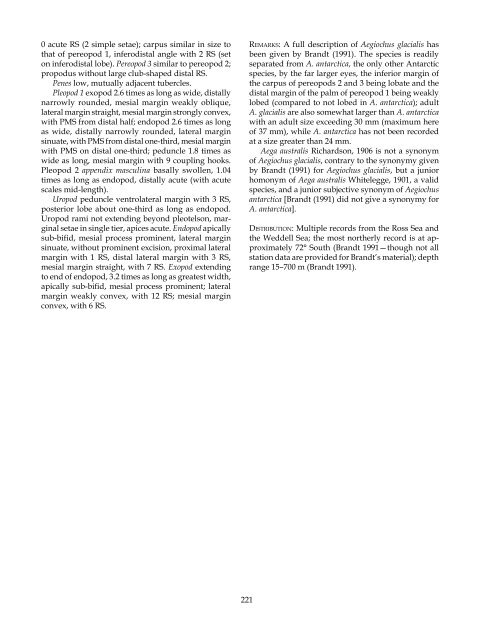The Marine Fauna of New Zealand: Isopoda, Aegidae (Crustacea)
The Marine Fauna of New Zealand: Isopoda, Aegidae (Crustacea)
The Marine Fauna of New Zealand: Isopoda, Aegidae (Crustacea)
Create successful ePaper yourself
Turn your PDF publications into a flip-book with our unique Google optimized e-Paper software.
0 acute RS (2 simple setae); carpus similar in size to<br />
that <strong>of</strong> pereopod , inferodistal angle with 2 RS (set<br />
on inferodistal lobe). Pereopod 3 similar to pereopod 2;<br />
propodus without large club-shaped distal RS.<br />
Penes low, mutually adjacent tubercles.<br />
Pleopod 1 exopod 2.6 times as long as wide, distally<br />
narrowly rounded, mesial margin weakly oblique,<br />
lateral margin straight, mesial margin strongly convex,<br />
with PMS from distal half; endopod 2.6 times as long<br />
as wide, distally narrowly rounded, lateral margin<br />
sinuate, with PMS from distal one-third, mesial margin<br />
with PMS on distal one-third; peduncle .8 times as<br />
wide as long, mesial margin with 9 coupling hooks.<br />
Pleopod 2 appendix masculina basally swollen, .04<br />
times as long as endopod, distally acute (with acute<br />
scales mid-length).<br />
Uropod peduncle ventrolateral margin with 3 RS,<br />
posterior lobe about one-third as long as endopod.<br />
Uropod rami not extending beyond pleotelson, marginal<br />
setae in single tier, apices acute. Endopod apically<br />
sub-bifid, mesial process prominent, lateral margin<br />
sinuate, without prominent excision, proximal lateral<br />
margin with RS, distal lateral margin with 3 RS,<br />
mesial margin straight, with 7 RS. Exopod extending<br />
to end <strong>of</strong> endopod, 3.2 times as long as greatest width,<br />
apically sub-bifid, mesial process prominent; lateral<br />
margin weakly convex, with 2 RS; mesial margin<br />
convex, with 6 RS.<br />
22<br />
remarks: A full description <strong>of</strong> Aegiochus glacialis has<br />
been given by Brandt ( 99 ). <strong>The</strong> species is readily<br />
separated from A. antarctica, the only other Antarctic<br />
species, by the far larger eyes, the inferior margin <strong>of</strong><br />
the carpus <strong>of</strong> pereopods 2 and 3 being lobate and the<br />
distal margin <strong>of</strong> the palm <strong>of</strong> pereopod being weakly<br />
lobed (compared to not lobed in A. antarctica); adult<br />
A. glacialis are also somewhat larger than A. antarctica<br />
with an adult size exceeding 30 mm (maximum here<br />
<strong>of</strong> 37 mm), while A. antarctica has not been recorded<br />
at a size greater than 24 mm.<br />
Aega australis Richardson, 906 is not a synonym<br />
<strong>of</strong> Aegiochus glacialis, contrary to the synonymy given<br />
by Brandt ( 99 ) for Aegiochus glacialis, but a junior<br />
homonym <strong>of</strong> Aega australis Whitelegge, 90 , a valid<br />
species, and a junior subjective synonym <strong>of</strong> Aegiochus<br />
antarctica [Brandt ( 99 ) did not give a synonymy for<br />
A. antarctica].<br />
distribution: Multiple records from the Ross Sea and<br />
the Weddell Sea; the most northerly record is at approximately<br />
72° South (Brandt 99 —though not all<br />
station data are provided for Brandt’s material); depth<br />
range 5–700 m (Brandt 99 ).

















